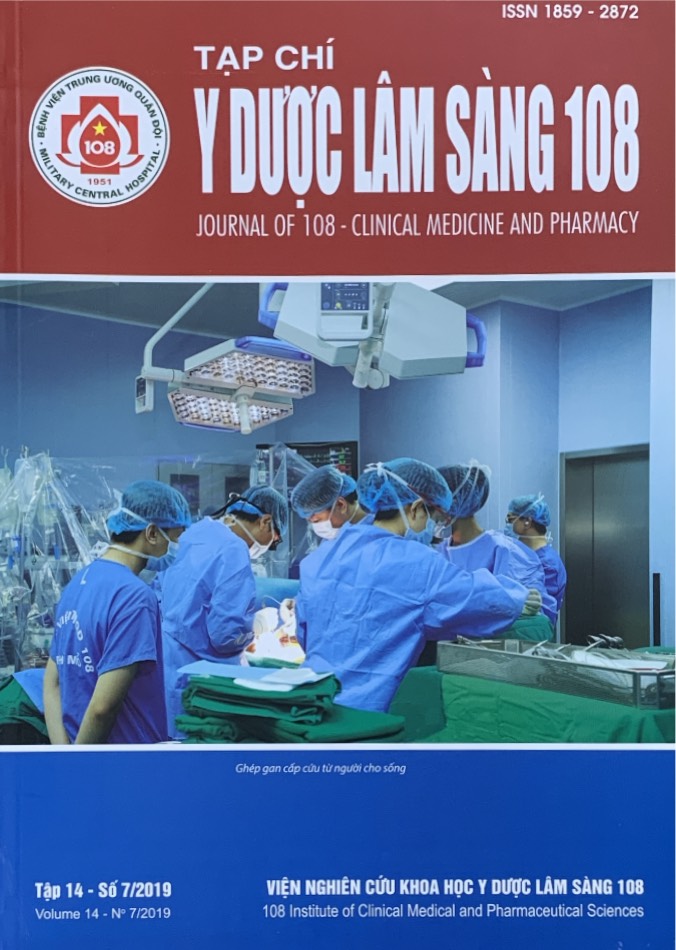Results of emergency ERCP in treatment of acute cholangitis and edematous pancreatitis caused by common bile duct stones
Main Article Content
Keywords
Abstract
Objective: To assess the results of endoscopic retrograde cholangiopancreatography (ERCP) in treatment of acute cholangitis and edematous pancreatitis caused by common bile duct (CBD) stones. Subject and method: This is an observation study of 72 patients. These patients were treated by emergency ERCP from Jan. 2016 to Mar. 2018 at the GI Department, 108 Military Central Hospital. Result: There were 29 males and 43 females with mean age 47.3 years. Of them, there were 6 cases of septic shock caused by common bile duct stones, 6 cases of acute obstructive suppurative cholangitis combined with acute edematous pancreatitits by CBD stones, 20 cases of acute edematous pancreatitis caused by CBD stones and 46 cases of acute obstructive suppurative cholangitis caused by CBD and common hepatic duct (CHD) stones. The success rate of ERCP was 70.8%. Average length of stay was 6.2 days. The overall results were no complications of ERCP after 1 month follow-up. Conclusion: Our study shows that emergency ERCP can be used effective and safe in treatment of acute obstructive suppurative cholangitis and edematous pancreatitis caused by extrahepatic stones.
Article Details
References
2. Cotton PB (1984) Endoscopic management of bile duct stones: (Apples and oranges). Gut 2: 587-597.
3. Itoi T, Kawai T, Atsushi S et al (2008) Efficacy and safety of 1-step transnasal endoscopic nasobiliary drainage for the treatment of acute cholangitis in patients with previous endoscopic sphincterotomy (with video). Gastrointest Endosc 68: 84-90.
4. Gogel HG, Bruce AR, Volpicelli NA et al (1987) Acute suppurative obstructive cholangitis due to stones: Treatment by urgent endoscopic sphincterotomy. Gastrointest Endosc 33: 210-213.
5. Hui C-K, Lai K-C, Yuen M-F et al (2003) Does the addition of endoscopic sphincterotomy to stent insertion improve draingae of the bile duct in acute suppurative cholangitis?. Gastrointest Endosc 58: 500-504.
6. Lee DWH, Chan ACW, Lam YH et al (2002) Biliary decompression by nasobiliary catheter or biliary stent in acute suppurative cholangitis: A prospective randomized trial. Gastrointest Endosc 56: 361-365.
7. Liu CL, Lo CM, Fan ST (1997) Acute biliary pancreatitis: diagnosis and management. World J Surg 21: 149-154.
8. Negm AA, Schott A, Vonberg R-P, Weismueller TJ, et al (2010) Routine bile collection for microbiological analysis during cholangiography and its impact on the management of cholangitis. Gastrointest Endosc 72(2): 284-291.
9. Sullivan DM, Ruffin-Hood T, Griffin WO (1982) Biliary tract surgery in the elderly. Am J Surg 143: 218-220.
10. Tenner S, Baillie J, Dewitt J et al (2013) American college of gastroenterology guideline: Management of acuter pancreatitis. Am J Gastroenterol: 1-16.
11. Zhang WZ, Chen YS, Wang JW et al (2002) Early diagnosis and treatment of sever acute cholangitis. World J Gastroenterol 8(1): 150-152.
 ISSN: 1859 - 2872
ISSN: 1859 - 2872
